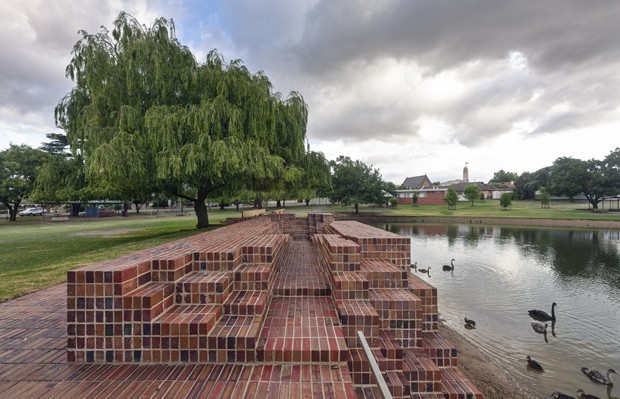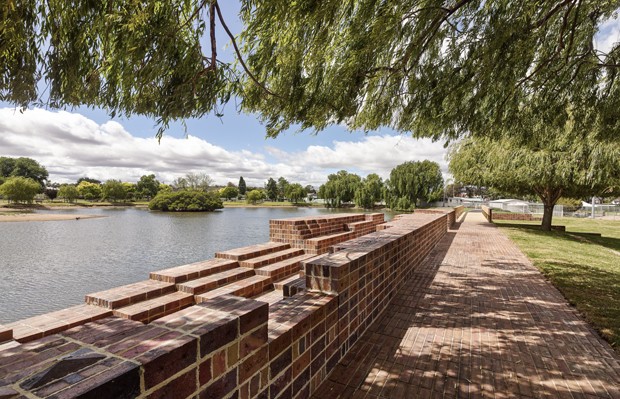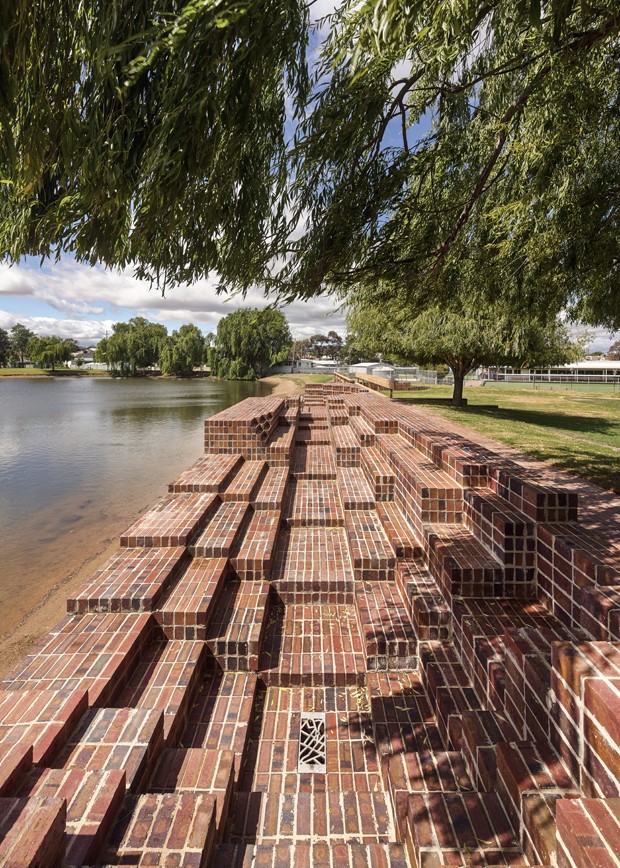An innovative approach to flood prevention designed by Monash Art Design & Architecture (MADA) students has received top honours at the 2013 National Awards for Excellence.
Commissioned by the Northern Grampians Shire Council after the 2011 floods caused over $20 million in damage to the local community, the Monash Steps/Stawell Steps project features an innovative brick design and forms a spillway at Cato Lake in Stawell, VIC.
The spillway, now an attractive and functional feature of Cato Park, redirects potential floodwaters and protects businesses and homes surrounding the lake from potential inundation.
At the same time, it doubles up as an engaging public space for park users to gather and enjoy views of the lake. The shades of existing willow trees along the banks are the perfect backdrop for picnics and small gatherings.
The innovative design was developed by fourth-year Monash architecture students in collaboration with Japanese artist Hiroshi Nikao and architect professor Nigel Bertram. Local engineers at the Northern Grampians Shire Council provided expert advice throughout the design and construction phase.

The students say that the Stawell Steps is the product of an intention to create a piece of infrastructure that is simultaneously functional, sculptural and inhabitable.
Inspired by the rich history of Stawell, they wanted the project to reflect the amalgamation of historic precedents, materiality and an engagement with the site. One of the key results of this desire is the heavy use of bricks made from clay by a local family business, Krause Bricks.
Hiroshi Nikao was also a key influence on the project, bringing with him a different cultural perspective and constantly encouraging the students to engage with the project and materials in an atypical way.

Apart from designing, the twenty students were also given the chance to learn the art of bricklaying from local bricklayers once construction began.
One of the students, Ashleigh Briggs, says that converting their aspirations and design into a buildable form was their greatest challenge.
“We weren’t only the architects of the projects. We were the builders, quantity surveyors and project coordinators. We had to engage with engineers, planners, local government, suppliers and qualified trades to a level none of us had ever done previously. It was a steep learning curve for all of us.”

In addition to winning the overall National Awards for Excellence category, the Monash Steps/Stawell Steps project also picked up the prize for Innovative Infrastructure Development. It was previously nominated as a finalist in the AIA Victorian Architecture Awards.
MADA’s Head of Architecture Dr. Diego Ramirez Lovering says that the awards reward the constructive collaboration between the local community, council and university, and supports innovation in local initiatives.
“It’s exactly the type of experience that we seek to provide…not introspective, but real, outward looking, and engaging multiple stakeholders.”
Briggs agrees, noting that being recognised for such a highly collaborative venture means that success tastes much sweeter.
“[It] is very exciting because you share your pride with not only your fellow students but with an entire community. We lived in the town of Stawell for over 8 weeks and…the community embraced the project and encouraged us. The Stawell Steps is a physical reminder of this relationship and to be awarded for our work is a huge affirmation for us and the entire town.”

National recognition for the Monash Steps/Stawell Steps project has also led MADA to be appointed for a pavilion commission at Hobart’s innovative Museum of Old and New Art (MONA) gallery.
This commission will be a collaborative venture between MADA students and a number of International Architecture Schools, including the Massachusetts Institute of Technology (MIT), Alvar Aalto Department of Architecture (Arkkitehtuuri) in Finland and the School of Architecture from Austin, Texas.

For more information about the project, please visit www.artdes.monash.edu.au.
Images: Peter Bennetts

